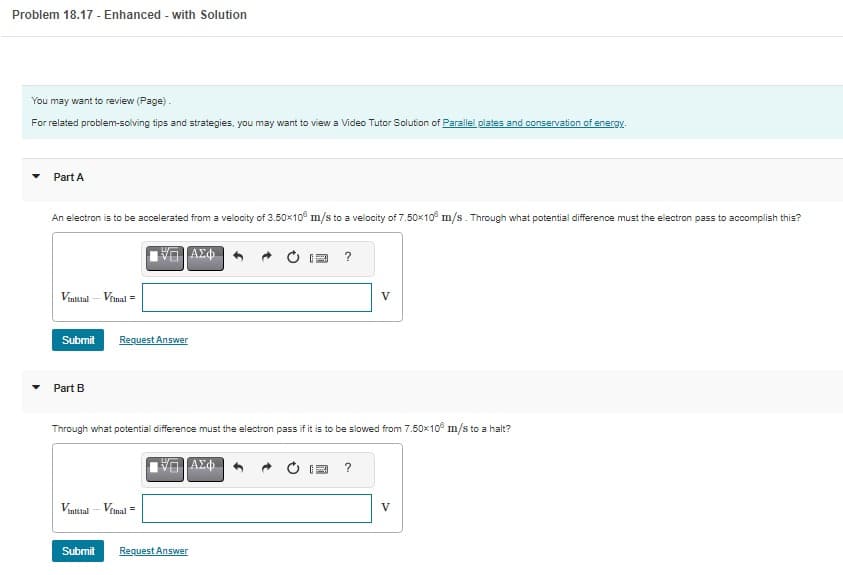kg. It moves from A small particle has charge -6.60 μC and mass 2.50x10 point A, where the electric potential is V₁ = 220 V, to point B, where the
kg. It moves from A small particle has charge -6.60 μC and mass 2.50x10 point A, where the electric potential is V₁ = 220 V, to point B, where the
College Physics
11th Edition
ISBN:9781305952300
Author:Raymond A. Serway, Chris Vuille
Publisher:Raymond A. Serway, Chris Vuille
Chapter16: Electrical Energy And Capacitance
Section: Chapter Questions
Problem 11P: An electron is at the origin, (a) Calculate the electric potential VA at point A, x = 0.250 cm. (b)...
Related questions
Question
![Problem 18.18
A small particle has charge -6.60 μC and mass 2.50x104 kg. It moves from
point A, where the electric potential is V₁ = 220 V, to point B, where the
electric potential V₂ = 620 V. The electric force is the only force acting on the
particle. The particle has a speed of 5.00 m/s at point A.
Part A
What is its speed at point B?
Express your answer in meters per second to three significant figures.
ID] ΑΣΦ
Submit
Part B
Is it moving faster or slower at B than at A?
Faster
Slower
Request Answer
Submit
Request Answer
?
m/s](/v2/_next/image?url=https%3A%2F%2Fcontent.bartleby.com%2Fqna-images%2Fquestion%2Ffc35e33c-c206-43ae-a5db-4f7b535d699d%2Fa691ccd5-c7bb-4236-9cbc-56865503f5da%2Fxb2a8a5_processed.jpeg&w=3840&q=75)
Transcribed Image Text:Problem 18.18
A small particle has charge -6.60 μC and mass 2.50x104 kg. It moves from
point A, where the electric potential is V₁ = 220 V, to point B, where the
electric potential V₂ = 620 V. The electric force is the only force acting on the
particle. The particle has a speed of 5.00 m/s at point A.
Part A
What is its speed at point B?
Express your answer in meters per second to three significant figures.
ID] ΑΣΦ
Submit
Part B
Is it moving faster or slower at B than at A?
Faster
Slower
Request Answer
Submit
Request Answer
?
m/s

Transcribed Image Text:Problem 18.17 - Enhanced - with Solution
You may want to review (Page).
For related problem-solving tips and strategies, you may want to view a Video Tutor Solution of Parallel plates and conservation of energy.
Part A
An electron is to be accelerated from a velocity of 3.50x108 m/s to a velocity of 7.50x10 m/s. Through what potential difference must the electron pass to accomplish this?
Vinitial - Vfinal =
Submit
Part B
ΕΠΙΑΣΦ
Request Answer
Vinitial - Viinal
Submit
Through what potential difference must the electron pass if it is to be slowed from 7.50x108 m/s to a halt?
Request Answer
?
ΑΣΦ
V
?
V
Expert Solution
This question has been solved!
Explore an expertly crafted, step-by-step solution for a thorough understanding of key concepts.
This is a popular solution!
Trending now
This is a popular solution!
Step by step
Solved in 6 steps

Knowledge Booster
Learn more about
Need a deep-dive on the concept behind this application? Look no further. Learn more about this topic, physics and related others by exploring similar questions and additional content below.Recommended textbooks for you

College Physics
Physics
ISBN:
9781305952300
Author:
Raymond A. Serway, Chris Vuille
Publisher:
Cengage Learning

College Physics
Physics
ISBN:
9781285737027
Author:
Raymond A. Serway, Chris Vuille
Publisher:
Cengage Learning

Physics for Scientists and Engineers: Foundations…
Physics
ISBN:
9781133939146
Author:
Katz, Debora M.
Publisher:
Cengage Learning

College Physics
Physics
ISBN:
9781305952300
Author:
Raymond A. Serway, Chris Vuille
Publisher:
Cengage Learning

College Physics
Physics
ISBN:
9781285737027
Author:
Raymond A. Serway, Chris Vuille
Publisher:
Cengage Learning

Physics for Scientists and Engineers: Foundations…
Physics
ISBN:
9781133939146
Author:
Katz, Debora M.
Publisher:
Cengage Learning

Physics for Scientists and Engineers, Technology …
Physics
ISBN:
9781305116399
Author:
Raymond A. Serway, John W. Jewett
Publisher:
Cengage Learning

Principles of Physics: A Calculus-Based Text
Physics
ISBN:
9781133104261
Author:
Raymond A. Serway, John W. Jewett
Publisher:
Cengage Learning
